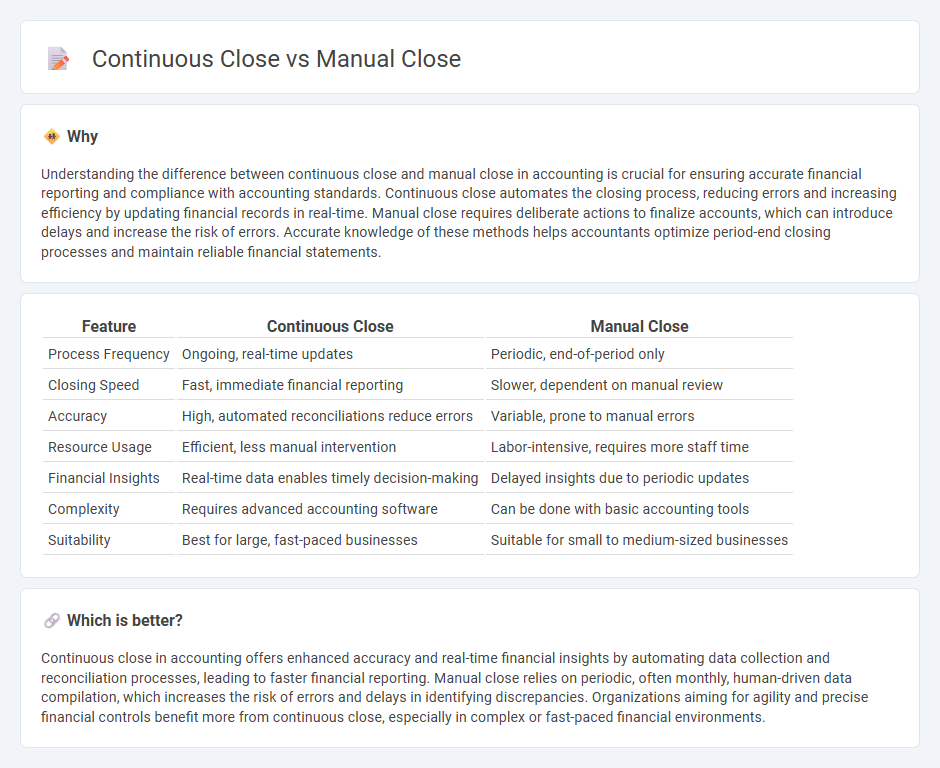
Continuous close in accounting automates the reconciliation and reporting processes, enabling real-time financial visibility and reducing the risk of errors. Manual close requires accounting teams to compile and verify financial data at specific intervals, often resulting in longer close cycles and increased labor costs. Explore the benefits and challenges of each approach to optimize your financial close strategy.
Why it is important
Understanding the difference between continuous close and manual close in accounting is crucial for ensuring accurate financial reporting and compliance with accounting standards. Continuous close automates the closing process, reducing errors and increasing efficiency by updating financial records in real-time. Manual close requires deliberate actions to finalize accounts, which can introduce delays and increase the risk of errors. Accurate knowledge of these methods helps accountants optimize period-end closing processes and maintain reliable financial statements.
Comparison Table
| Feature | Continuous Close | Manual Close |
|---|---|---|
| Process Frequency | Ongoing, real-time updates | Periodic, end-of-period only |
| Closing Speed | Fast, immediate financial reporting | Slower, dependent on manual review |
| Accuracy | High, automated reconciliations reduce errors | Variable, prone to manual errors |
| Resource Usage | Efficient, less manual intervention | Labor-intensive, requires more staff time |
| Financial Insights | Real-time data enables timely decision-making | Delayed insights due to periodic updates |
| Complexity | Requires advanced accounting software | Can be done with basic accounting tools |
| Suitability | Best for large, fast-paced businesses | Suitable for small to medium-sized businesses |
Which is better?
Continuous close in accounting offers enhanced accuracy and real-time financial insights by automating data collection and reconciliation processes, leading to faster financial reporting. Manual close relies on periodic, often monthly, human-driven data compilation, which increases the risk of errors and delays in identifying discrepancies. Organizations aiming for agility and precise financial controls benefit more from continuous close, especially in complex or fast-paced financial environments.
Connection
Continuous close and manual close are interconnected accounting processes that ensure timely and accurate financial reporting. Continuous close automates routine transaction validations and reconciliations throughout the accounting period, minimizing errors and workload during manual close at period-end. Manual close complements this by enabling accountants to review complex entries, make adjustments, and finalize financial statements for compliance and audit readiness.
Key Terms
Period-End Processes
Manual close requires finance teams to individually finalize accounting entries and reconcile accounts, often leading to longer close cycles and increased risk of errors during period-end processes. Continuous close automates data collection and validation in real-time, streamlining financial consolidation and enabling faster, more accurate period-end reporting. Explore the advantages of continuous close to enhance your organization's financial closing efficiency.
Real-Time Data
Manual close requires human intervention to finalize transactions, often leading to delays and potential errors in data recording. Continuous close automates the process, enabling real-time data updates that enhance accuracy and operational efficiency. Discover how adopting continuous close can transform your financial reporting and decision-making with real-time data integration.
Reconciliation
Manual close requires physical intervention to finalize transactions, which can increase the likelihood of errors and delay reconciliation processes. Continuous close automates transaction finalization throughout the day, enhancing accuracy and enabling real-time reconciliation, thus improving financial reporting velocity. Discover how implementing continuous close can streamline your reconciliation workflow and reduce audit risks.
Source and External Links
How To Manually Open And Close Your Garage Door - This guide provides steps on how to manually open and close a garage door, including disengaging the automatic opener and manually moving the door.
How To Manually Close The Garage Door - This article outlines safety precautions and steps to manually close a garage door, ensuring safety and security.
Manual closing of problems - This documentation explains how to manually close problems in Zabbix, requiring the "Allow manual close" option to be enabled.
 dowidth.com
dowidth.com